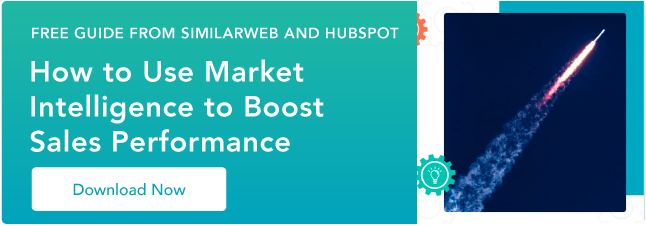You’re nearing the end of the sales process. You had a good discovery call with your prospect, ran a strong demonstration, and are handling standard objections. Then, you get a phone call.

“Hi,” the decision maker on your account says. “I just wanted to call and let you know that we’re probably going to go with a competitor.”
What do you do?
It may seem like your deal is sunk, but don’t worry, you still have options. It’s not over yet -- follow these seven steps to put yourself back in play.
How to Win a Competitive Deal
1) Get yourself on the decision maker’s calendar.
Don’t get angry. Your prospect has done you a favor by calling and giving you a heads up. Many leads simply stop picking up the phone and don’t even have the courtesy to tell you they’ve gone in another direction. Thank her for letting you know.
Ask the decision maker to bring you up to speed. Are there features or services she’s looking for that you don’t provide (or she doesn't know you provide)? Are there intangibles that affected this decision (for example, does an employee from a competing company sit on their board of directors)?
Listen for specific reasons she’s chosen to go in a different direction, and see if that squares with your understanding of her problem.
Set a call for the next day. Ask, “Can I review my notes and send you a response within 24 hours?” Thank your prospect for their time and get to work!
2) Review your notes.
Look over everything you’ve ever sent or received from your prospect -- emails, call notes, and resources. Use the following questions to guide your review:
- Did you miss an indicator that this account is a bad fit?
- Did you gloss over a particular product strength that’s important to your prospect?
- Did your discussions focus on issues important to your prospect?
- Have those issues changed along the way?
3) Call your coach.
In B2B sales, a coach is somebody at a target company with insight into a purchasing decision who can give you the inside track on decision criteria, stakeholder priorities, and appropriate next steps.
Call your coach as soon as possible and let him know there’s a problem. Find out the current status of the deal. Is a contract signed with a competitor? Or are there still a few final things to iron out before the door closes?
If there’s any inside baseball you need to know about, now is the time to ask. Are there people blocking your product? Is there an especially important piece of the decision process you didn’t know about?
4) Gather competitive intelligence.
You walk a fine line when you’re compiling competitive information. You have to be fairly aggressive but avoid disparagement or rudeness. The best type of competitive intelligence is an objective third-party assessment that stacks your company up against its competitors, so it’s free of partiality.
5) Send materials in advance.
Prepare your case in writing first. Then, send it over to the prospect's team prior to your scheduled call so they have time to review everything before you speak.
6) Speak with your prospect.
Thank your decision maker again, and then ask if everyone has read the materials before proceeding. This is an early indicator of how things will go -- if they’ve reviewed what you’ve sent them, you still have a shot.
Ask her to walk through the steps that led them to choose your competitor again. See if anything conflicts with her previous explanation. If both stories line up perfectly, she’s likely the driving force behind the decision.
Spend no more than 10 minutes highlighting reasons why your product is superior. Don’t let this drag on too long -- after all, you’re trying to get back in the fight. Go for the most impressive points of differentiation instead of trying to cover everything.
The goal of the call isn’t necessarily to win the deal back on the spot. If you can, that’s great. But above all, aim to cover a few points that will put you back in play.
7) Go for the touchdown.
After your call, assess your options. What Hail Mary passes do you have in your back pocket that will wow a prospect?
Some tactics I’ve used over the years:
- Have one of your best customers call your prospect (preferably one who’s evaluated the competitor as well)
- Have one of your executives call your prospect (only if there’s a personal connection)
- Invite your prospect to visit your headquarters and give a formal presentation
- Visit your prospect’s headquarters
These plays are big. Their purpose is to show you’re willing to make an extra effort to win the deal. You can even tell your prospect, “I want to be helpful. If there is anything we can do to earn your consideration, please let me know.”
Always emphasize that you’re doing this with the intention of signing your prospect on as a new customer. This will be their decision point. If your decision maker is willing to talk next steps with you, she’s still making her final evaluation and there’s hope for your product. If she’s not, it’s done.
If You Lose the Deal
Accept it with grace and move on. Let them know you completely understand and that you’re always here if they need you. Even top salespeople lose deals. The key is to follow a good sales process and control what you can.
I sometimes call prospects that I lost to a competitor about 90 days after the deal is closed. (In software, that’s around the time where implementation starts getting gnarly.) Determine what that time period looks like for your product and schedule a call on your calendar. Ask your prospects how the product is working out for them, then see if they’d like to be put on a drip campaign for all your top content related to their problem. Tell them if it gets too hard, you’re happy to help.
It’s never fun to lose a deal to a competitor. But hopefully by following these seven steps, you can win back a good portion of sales.









![Losing Clients to the Competition? These 3 Culprits Could Be to Blame [Research]](https://blog.hubspot.com/hubfs/shredded_contract.jpg)

